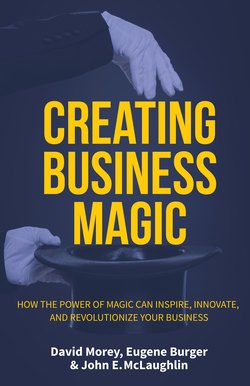Читать книгу Creating Business Magic - David Morey - Страница 7
На сайте Литреса книга снята с продажи.
ОглавлениеPreface
Who Should Read This Book?
You may think you know what magic is. Abracadabra, hocus-pocus. Forget about it. Magic? Magic is what human beings do. It’s just that some do it a lot better than others.
Take the wheel. Archaeologists tell us it’s been around since about 4000 BC. Before then, if you had something heavy to move, you dragged it. Or at least tried to. That meant you probably couldn’t move very much very far. Without even the idea of a wheel, you could either drag your things or imagine some magical force that could move them. The status quo—“the way things stand”—stood in your way.
What you needed was something to disrupt the status quo. The first step was to imagine the disruption—what it looked like, what it did, how people perceive the changes it makes. Imagine it thoroughly enough, and you could invent what you needed. Somewhere in our long history, some people began to realize that imagination was so powerful and useful, it should be made more available when and where it was needed. They were the people who systematized imagination and the disruptions it created. Today, we call such people designers, architects, engineers, scientists, artists, entrepreneurs, inventors, and innovators. In the past, they were more typically called magicians.
Once the wheel was imagined and invented—call it “conjured”—whenever you needed to move something, you no longer needed the disruption wrought by magic. All you needed were wheels. At least that’s what you thought. The truth is that the wheels were the magic: the embodiment of imagination that made the impossible possible.
This is the course of history. Once the magic drove someone’s imagination to disrupt the motionless status quo by inventing wheels, all anyone saw from then on were the wheels, and they forgot about the magic behind them. Wheels became the status quo. The disruption of reality became the new reality, which, after a while, wasn’t new. That’s the way all earth-shaking innovation works. First comes the magic, and then the magic becomes the reality.
Magic always was and always will be about creatively solving problems: satisfying a need, a want, a desire in some unheard-of way. The more creative and powerful the solution, the more disruptive of the status quo, the more magical it seems—at least until people cannot live without it. If, for instance, you were born in the age of the public phone booth, there is still magic in your smartphone—though even for members of the payphone generation, the smartphone magic fades a little day by day. That is what drives the journey from 5.0 to 6.0 to 7.0 and beyond.
Familiarity doesn’t change the fact that our supply of magic is limitless. We just need somebody to help us tap into it. That’s what Creating Business Magic is all about. This book uses the power and the metaphor of magic to help you unlock your imagination, creativity, and career, thereby disrupting your personal status quo.
Where did we get the magic?
We are practicing magicians who also happen to have other careers—in leadership, marketing, corporate strategy, political strategy, intelligence, education, diplomacy, global policy, philosophy, and the history of religion. We each make our living through what is often called thought leadership in our respective “day job” fields. Clients pay us to—in the words of Steve Jobs—“think different.” Put another way, we sell disruption. We deliver magical ways to think differently.
For this reason, we put magic to work onstage as well as in everything else we do for a living. We learned a lot of our magic from the great magicians who have come before us, from stage magicians like Max Malini, Harry Houdini, Harry Blackstone, Tony Slydini, Doug Henning, and David Copperfield, but also from magicians known by other names: Isaac Newton, Albert Einstein, Kelly Johnson, Roberto Goizueta, Corazon Aquino, and Steve Jobs. In fact, we’ve drawn our magic from everyone we’ve worked with or known or just read about—from all the people who “think different,” and in thinking differently, disrupt companies, industries, economies, cultures, and governments.
This book takes everything we’ve learned about magic and packs it into a unique framework that defines and captures the best of magic—from renowned magicians to performance art to empowering imagination—and relates it directly to key lessons learned in a variety of creative, governing, and commercial fields. Our “Strategies” conclude with a concise “payoff” that delivers specific, momentum-building action lists: Creating Business Magic strategies that will show you how to be the magician in your own life, career, and future.
